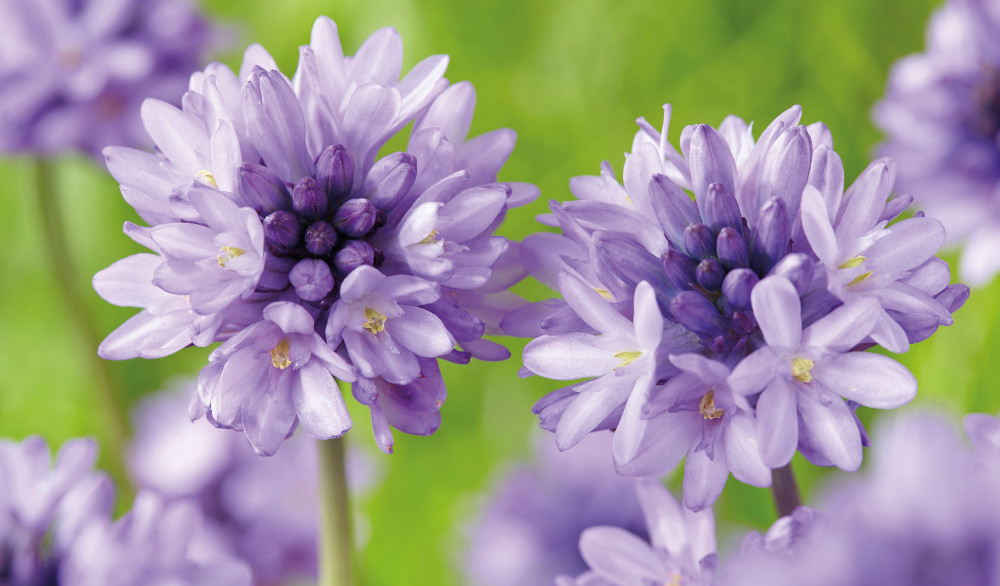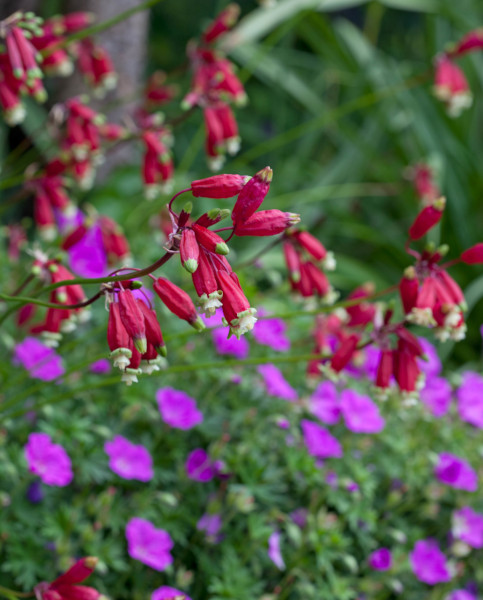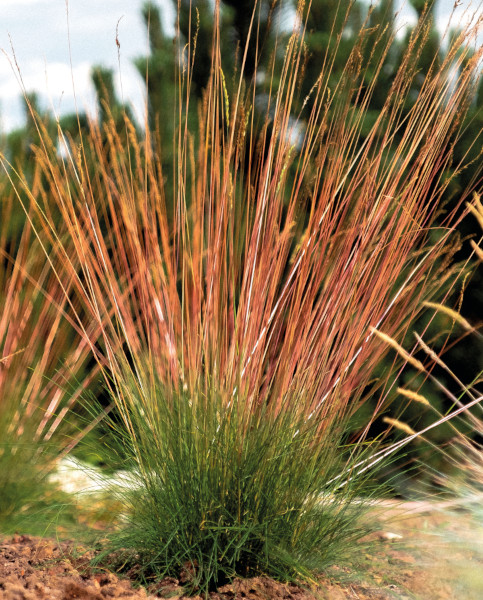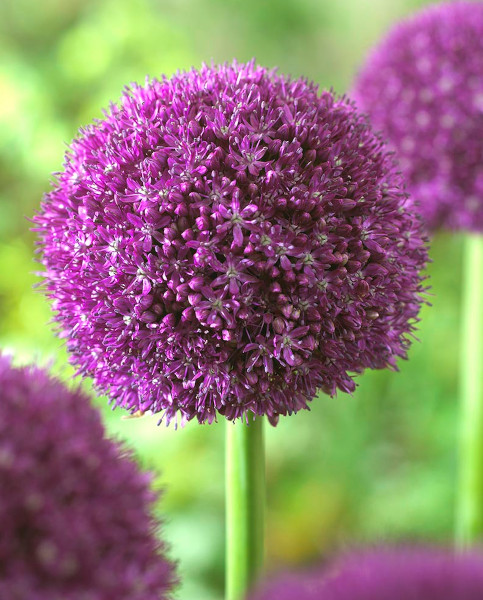How to grow Dichelostemma
Dichelostemma are generally half-hardy, perennial corms. A wide genus that was once classified as a member of the Lily family, most of them originate from North America.
Related to the wild hyacinth, Dichelostemma bring a wild and airy quality to your garden in late spring and summer.
Dichelostemma are a cormous perennial that are so easy to grow, they form corms that that look a little like tubers of a sweet potato. Also known as Firecracker Flowers, because of the resemblance of the flower. Almost allium-like, the majestic blooms are held high on stately stems which grow though the thin, grass-like foliage. The tight, long-lasting umbel that sits atop, is created by clusters of many, small, bell-shaped blooms and look rather like spiky balls of soft, subtle colour as they magically float above other perennials in your spring and early summer garden. Much loved by pollinating insects, visiting your garden for a feast.
Similar in care to Allium, Dichelostemma are best suited to growing in sheltered borders and look incredible planted into patio pots and containers, happy to take centre stage. They are also excellent as cut flowers for indoor arrangements, lasting well in a vase.
You should expect to see your Dichelostemma plants grow to and height of anywhere between 30- 90cm and a spread of 10-30cm dependant on the variety. Dichelostemma are generally pest and disease free.

Key Information
Soil Conditions
Position
Hardiness


Where & when to plant Dichelostemma
Dichelostemma are best planted in the autumn, but if you cannot plant them as soon as they arrive with you, please store the package carefully in a dry place in temperatures between 4-20°, with plenty of air circulation.
Like many bulbs and corms, Dichelostemma need a cold snap to develop a strong root system in readiness for spring growth. So please remember not to store your corms too long before planting them out – later planting may result in a few less blooms the following spring.
Bulbs and corms are like tough storage containers for energy and nutrients, but they cannot cope with getting too wet. If they ‘sit’ in soil that is too wet, they will rot. If you are worried this is the case, improve the drainage by adding some bark, or other organic matter.
Dichelostemma need a sunny spot, so chose your planting area carefully.
How to plant Dichelostemma
Dichelostemma corms look a little like small onions. Plant your corms at an ambient temperature, around 12cm deep and about 15-20cm apart, with the pointed end upwards in well-drained soil. As a general rule of thumb, bulbs should be planted at a depth around 2-3 time the height of your bulb. If drainage is doubtful, add sand or grit to the bottom of the hole before putting the bulb in place then in-filling with soil. Water the soil well to help everything settle, then you shouldn’t need to water again unless the weather becomes exceptionally dry.
If planting in containers, remember that your bulbs will not be as well protected as they are if planted in the ground. As with planting in the ground, ensure drainage is good by adding old crocks or stones to the bottom of the container. You could plant bulbs a little closer to each other in a container, but please make sure that the bulbs do not physically touch.
Dichelostemma will happily naturalise. To gain a natural distribution, grab a handful of bulbs and gently throw them as if skimming stones. Plant the bulbs where they land, providing they ae more than 8cm apart.
Dichelostemma bulbs are hardy to around -5°C, so we would recommend that you apply a layer of mulch to help insulate the bed and protect from the coldest of temperatures. If the bulbs are planted into a pot, you may wish to move the pot to a sheltered location in your garden.
What to plant with Dichelostemma
Cultivated for their showy flowers, Dichelostemma are great for adding valuable form and texture to any gardening scheme whether formal or informal, modern or traditional.
For the best visual impact, plant Dichelostemma in groups where the corms will naturalise to form fantastic drifts, creating quite a display.
Dichelostemma like a sunny spot, so plant with other sun lovers. Dichelostemma congestion looks stunning when planted with the colours of Allium moly, Allium Yellow Fantasy or Allium Hair. Try growing with perennials such as Achillea Summer Gold. Dichelostemma ida-maia, with its bright red blooms grow well with Allium nectaroscordum Siculum or try growing through Sedum Thundercloud, where the colour will contrast against the evergreen, dark foliage.
Dichelostemma also look wonderful when grown through grasses, where they will weave their way. Festuca glauca Elijah Blue will create a colourful, evergreen backdrop for a wonderful prairie or wildflower meadow feel.



How to care for Dichelostemma
Dichelostemma are easy to grow, requiring very little maintenance once they are established.
During active growth, you will need to water your bulbs during dry periods if there hasn’t been rain for several days, taking care not to overwater and cause the bulbs to rot.
Once the flowering period is over, do not remove any foliage until it has turned yellow then brown, this could take several weeks. This is important because the leaves will still be photosynthesising, which creates essential nutrients that are stored back in the bulb, ensuring it has enough energy to flower again the following year. Dichelostemma will then enjoy a dormant summer, requiring warm, dry conditions, so try to avoid watering. The bulbs will be taking a well-earned rest ready to burst into action again the following spring.
Dichelostemma can be propagated by seed, which should be sown in the autumn. Usually germinating readily, the seed do not require any special treatment. You will need to be patient however, as when grown from seed the plants can take several years to reach the maturity to enable them to flower. Alternatively, you can create more plants rather more quickly by just removing offsets in late summer or dividing clumps to replant in other areas of your garden.
How to propagate Dichelostemma
Urginea are imposing plants, creating a dramatic statement when planted alone, creating quite an impressive clump when they have naturalised.
However, when grown amongst grasses or interspersed Allium they look incredible.
When choosing companion plants, think about the growing conditions that are preferred by each plant. Maybe grow Urginia maritima with Allium Forelock, Moly or Hair – the almost globe-like spheres of blooms will hover above the foliage but will have faded by the time the Urginea flowers have fully developed so will not detract from the spectacle.
Whether grown in borders or containers, the period when the foliage is absent could be filled with a low growing, evergreen carpet of Delosperma Suntropics Purple, Copper or Red, which become covered with bright almost neon coloured daisy-like flowers from spring until the first frosts.




